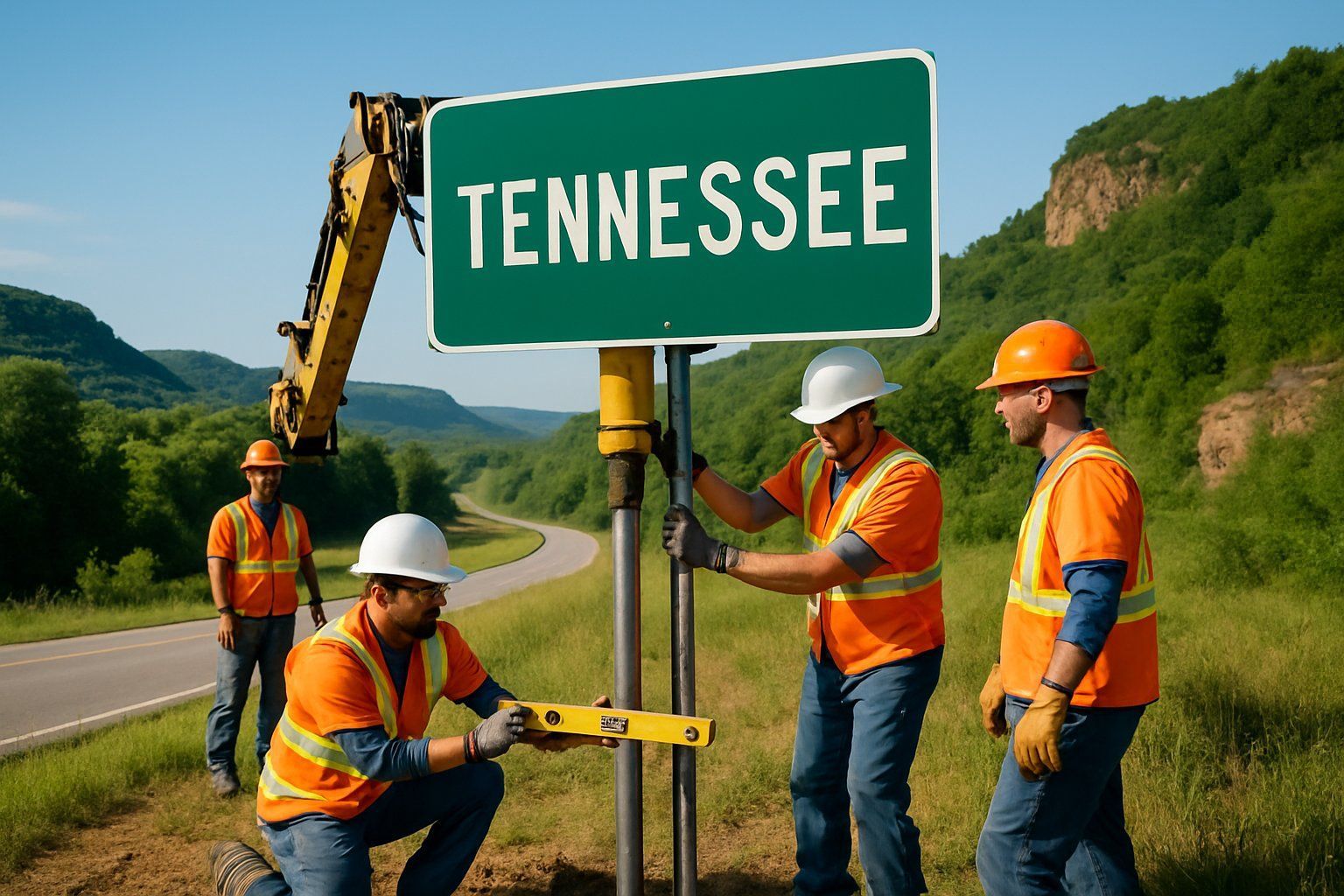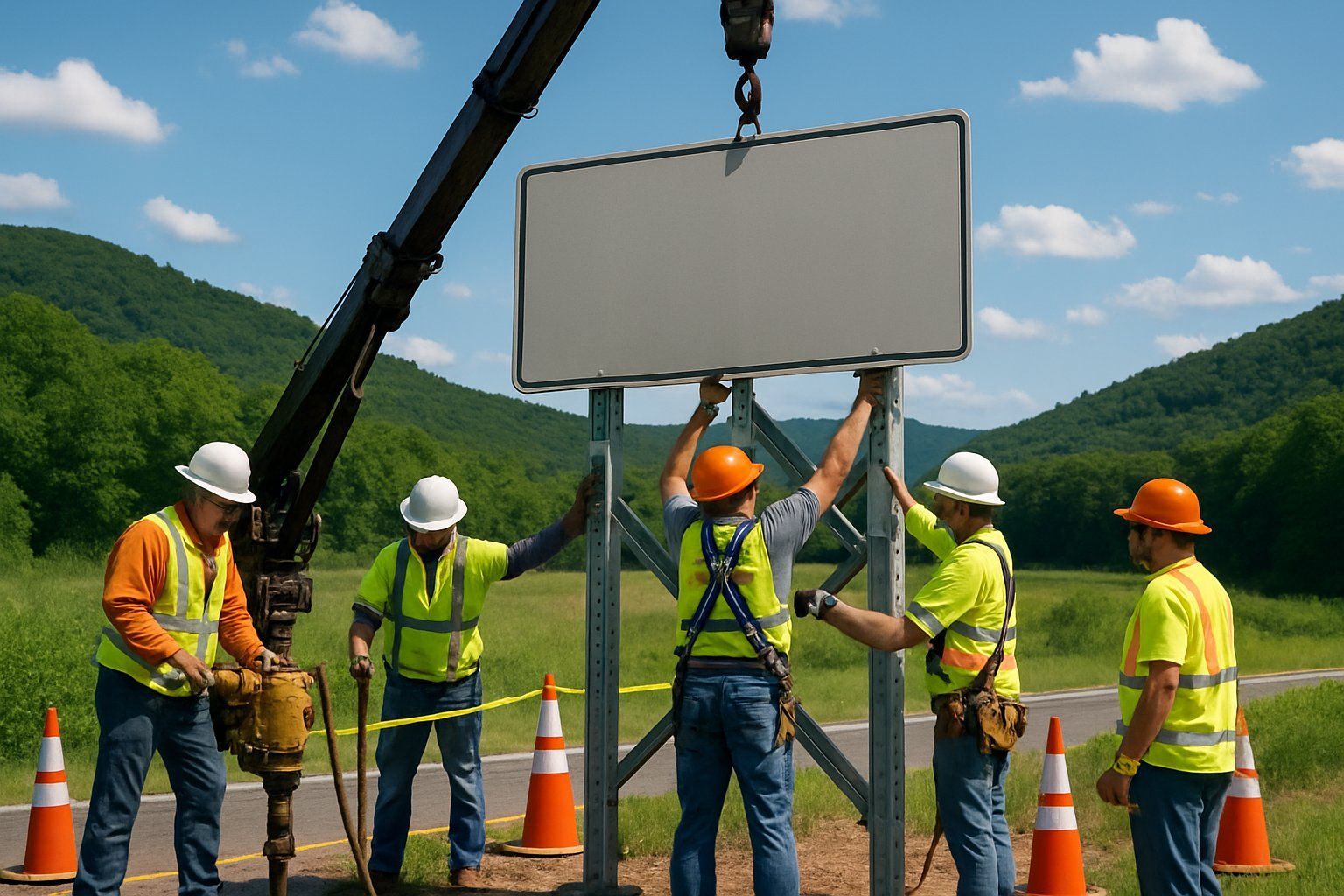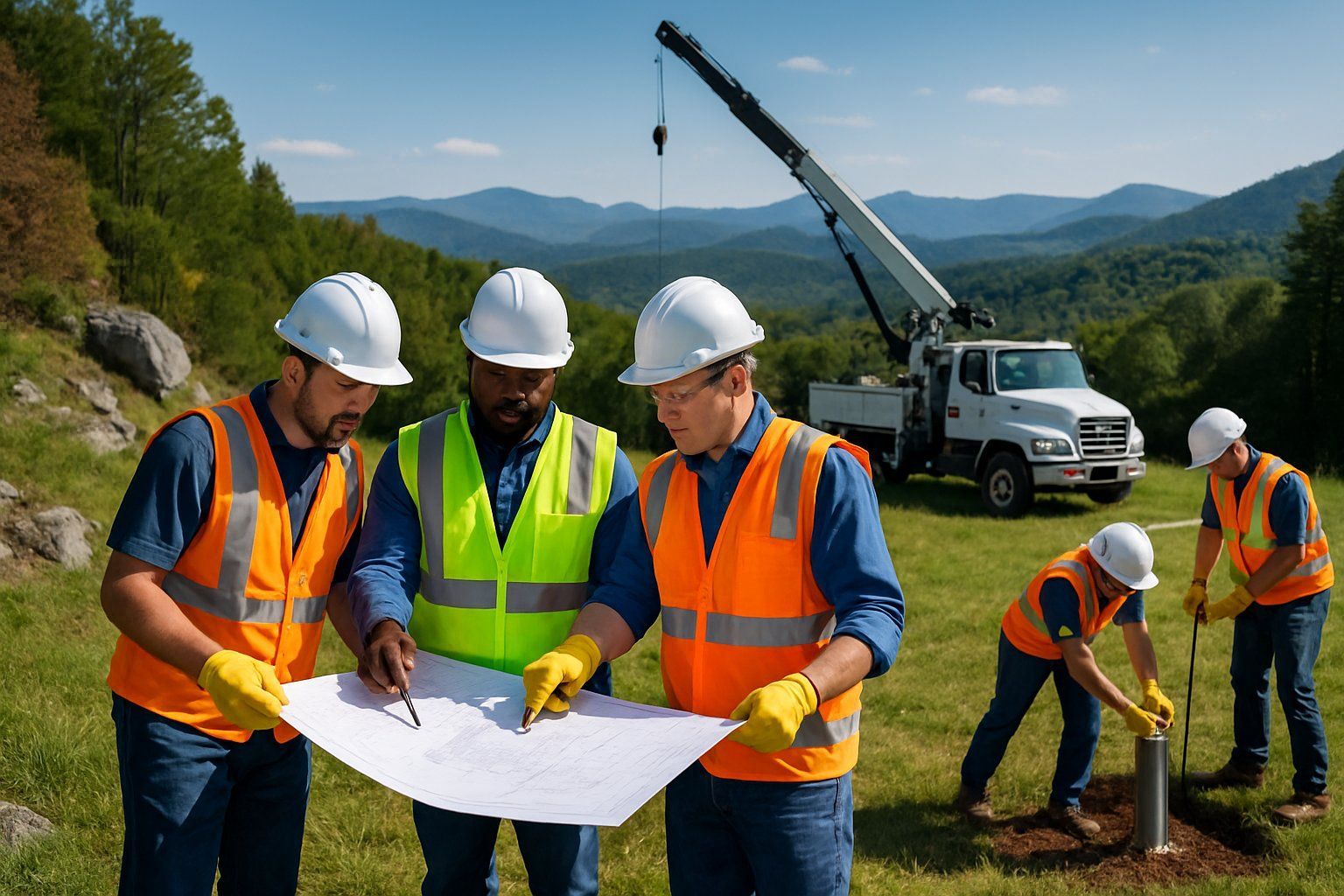Best Practices for Sign Installation Across Tennessee Terrains: Structural and Safety Guidelines
Installing signs across Tennessee’s diverse terrains requires careful planning and attention to both structural and safety needs. Varied landscapes, from mountainous regions to flat plains, demand different mounting methods and materials that can withstand weather, wind, and environmental stress.
Proper installation ensures signs remain stable, visible, and safe for the long term, regardless of the local conditions.

Understanding the site conditions before installation is essential. This means conducting a thorough survey to identify obstacles, traffic flow, and potential hazards.
Equally important is following Tennessee’s regulations to avoid fines or removal. Compliance protects both the property owner and the public.
Safety during installation cannot be overlooked. Using the right equipment, securing ladders or scaffolding, and following electrical guidelines helps prevent accidents.
Professionals trained for these tasks are often the best choice to ensure signs are installed correctly and safely. This delivers a durable and professional result.
Key Takeways
- Thorough site analysis guides proper placement and mounting choices.
- Compliance with local rules is necessary to avoid penalties.
- Safety protocols protect workers and ensure secure installations.
Fundamentals of Sign Installation in Tennessee

Installing signs in Tennessee requires careful planning due to the state’s varied landscapes and weather. Structural strength and safety rules must be followed to ensure signs last and remain secure.
Proper materials and techniques are key to handling the challenges posed by the terrain and climate.
Understanding Tennessee Terrain Challenges
Tennessee’s terrain includes mountains, hills, plains, and river valleys, each creating unique challenges for sign install. Rocky or uneven ground requires specialized mounting methods to ensure stability.
For example, signs in mountainous areas often need deeper foundations or reinforced supports to handle soil shifts. Heavy rainfall and occasional flooding can affect site conditions, requiring weather-resistant materials.
Outdoor signs near rivers or wetlands must be protected against moisture damage and corrosion. Wind speeds also vary widely across the state, so signs in open or elevated locations need strong anchoring to withstand gusts.
Proper site surveys identify these environmental factors early. This step helps professionals plan the best sign placement and structural design for long-term durability in all Tennessee terrains.
Key Principles of Structural Integrity
Structural integrity is crucial for safe sign installation. The support system must match the sign’s weight, size, and exposure to weather.
Engineers often follow standards like those from AASHTO for designing posts and brackets, ensuring signs hold up under wind, snow, and other forces. Mounting methods include flush mounts, post mounts, and wall mounts.
Each method has strengths depending on location and sign type. For example, post mounting is ideal for freestanding signs in open spaces but requires strong footings to resist wind.
Material choice affects durability. Steel and aluminum are common due to their strength and corrosion resistance.
Special coatings or treatments add protection against rust and UV damage, extending a sign’s lifespan in Tennessee’s varied climate.
Essential Safety Considerations
Safety during sign install protects workers and the public. Professional sign installation teams should use personal protective equipment such as helmets, gloves, and eye protection at all times.
Secure ladders and scaffolding are necessary for elevated installations. Electrical safety is critical when signs have lighting.
Only licensed electricians should handle wiring to meet local codes and avoid hazards. Traffic control measures, like cones or barriers, are needed when working near roads to prevent accidents.
Safety also means following local regulations. Tennessee requires permits for certain signs, and failure to comply can lead to fines or removal.
Proper planning and knowledge of rules ensure installations are both safe and legal.
Site Assessment and Preparation

Proper site assessment and preparation set the foundation for secure and effective sign installation. It involves gathering accurate information about the location, traffic behavior, and ground conditions.
These factors help determine the best positioning and mounting methods to ensure the sign’s stability and visibility.
Conducting Site Surveys
A site survey collects precise measurements and examines all physical aspects of the installation area. This includes checking for nearby structures, underground utilities, and potential obstacles that could interfere with the sign.
Surveyors use tools like measuring tapes and laser distance meters for accuracy. They document the space available and note any zoning or permit restrictions that may affect placement.
A thorough survey ensures the sign fits in the intended space and complies with local regulations. It also identifies access points for installation equipment and helps plan safe placement away from hazards.
Evaluating Traffic Flow and Traffic Patterns
Understanding traffic flow and patterns is essential to maximize a sign’s visibility and effectiveness. The installation site should be chosen where both vehicle and pedestrian traffic pass frequently and have clear sightlines to the sign.
Analyzing peak hours and movement directions helps determine the sign’s optimal angle and height. This ensures that drivers and walkers can read the sign safely without distractions or obstructions.
Maps, traffic studies, and local data provide insight into traffic density and speed. Positioning a sign too close to curves or intersections should be avoided to prevent blocking sightlines or causing confusion.
Analyzing Environmental and Soil Factors
Environmental and soil conditions directly affect sign stability and longevity. Installation teams must evaluate soil type—whether it is sandy, rocky, or clay—to select the right foundation and mounting hardware.
They consider factors like wind exposure, sun placement, and rainfall, especially important in Tennessee’s varied climates. For windy areas, reinforced supports and secure fasteners reduce the risk of damage.
Checking for drainage issues prevents water pooling around the base, which can weaken soil and cause structural problems. Selecting weather-resistant materials and coatings protects the sign against rust, fading, or warping from seasonal changes.
Compliance with Local Regulations and Approvals
Proper compliance with local regulations is essential when installing signs in Tennessee. This includes obtaining the correct permits, following zoning laws, and meeting state and municipal codes.
Without these steps, a sign installation can face costly delays, fines, or forced removal.
Navigating Permits and Approvals
Before installing a sign, businesses must secure commercial sign permits from the local government or zoning authorities. These permits regulate the size, placement, and illumination of the sign to ensure safety and legality.
The application process usually requires submitting detailed plans that show the sign’s dimensions, location, and materials. Approval timelines vary by city or county.
Businesses should allow time for this process to avoid installation delays. Renewing permits or applying for modifications is also necessary if the sign changes or requires maintenance.
Failure to obtain proper permits can lead to penalties or removal.
Meeting Zoning and Signage Requirements
Zoning laws control where signs can be placed in Tennessee. These rules specify allowed sign types, sizes, heights, and distances from roads or property lines.
For example, outdoor signs near highways must avoid obstructing traffic views or violating setback requirements. Some areas have limits on how bright or illuminated signs can be to reduce glare or light pollution.
Properly following zoning rules avoids legal issues and helps signage remain effective and visible. Businesses should review local zoning maps and consult authorities before planning their sign installation.
Adhering to State and Municipal Codes
In addition to permits and zoning, signage must meet state and local building codes related to structural safety and electrical systems. Signs should be mounted securely to withstand Tennessee’s varying weather, including wind and rain.
Electrical connections for illuminated signs must follow state electrical codes to prevent hazards. Municipal codes may require inspections after installation to verify compliance with safety and construction standards.
Keeping records of inspections and certifications supports ongoing compliance and signage investment protection.
Choosing Materials and Tools for Tennessee Conditions
The choice of materials and tools plays a critical role in sign installation across Tennessee’s diverse landscapes. Selections must address factors like humidity, wind, and varied soil types to ensure stability and safety.
Proper tools and fasteners are necessary to handle these conditions effectively and comply with safety standards.
Selecting Durable Signage Materials
Tennessee’s weather includes heat, rain, and occasional strong winds, making durability a priority. Materials like aluminum and high-density polyethylene resist corrosion and warping better than wood or untreated metals.
These materials stand up to humidity and temperature fluctuations without losing shape or color. For outdoor signs exposed to sunlight, UV-resistant coatings help prevent fading.
Reflective sheeting improves visibility, especially on roadways or busy streets. Signs installed in wetter areas should avoid porous materials to reduce mold and rot risk.
Choosing lightweight yet strong materials can ease installation and reduce the need for heavy supports, which helps in uneven or soft soil areas common in rural Tennessee.
Essential Tools for Installation Success
A successful sign installation depends on using the right tools. A drill with various bits is essential for making precise holes in different mounting surfaces like wood, brick, or metal.
A measuring tape and level assist in achieving accurate placement and straight lines, which are critical for both appearance and safety. Workers should always use personal protective equipment (PPE) such as gloves, goggles, and hard hats to maintain safety during installation.
For elevated signs, using a sturdy ladder or scaffold is necessary to reach the mounting location safely. Proper tool maintenance and inspection before use prevent accidents.
Proper Use of Fasteners and Supports
The choice and application of fasteners depend on the sign’s size, weight, and mounting surface. Stainless steel bolts, screws, and anchor bolts offer strong resistance against Tennessee’s humid climate and rust formation.
Fasteners must be compatible with the sign material and the building or ground structure. For instance:
- Masonry walls require expansion anchors or screws with anchors.
- Wood surfaces need corrosion-resistant screws.
- Metal surfaces often use bolts with lock washers.
Supports should be chosen based on environmental factors like wind load. Heavy signs need reinforced brackets or poles secured deeply into stable soil to avoid shifting or toppling in storms.
All fasteners and supports must be installed according to local building codes to meet safety regulations and avoid future repairs.
Installation Best Practices Across Varied Terrains
Installing signs in Tennessee requires attention to the terrain’s unique challenges. Different surfaces demand specific mounting methods, tools, and safety precautions to ensure signs remain stable and visible.
Proper placement and mounting techniques directly impact the durability and safety of outdoor signs in any environment.
Secure Mounting Techniques for Rocky and Uneven Surfaces
Rocky or uneven surfaces call for specialized mounting hardware. Heavy-duty anchors or expansion bolts are effective for securing signs into rock or masonry.
Drilling precise pilot holes reduces the risk of cracking or damaging the mounting surface. Using adjustable brackets can compensate for uneven ground or surface angles.
This helps maintain a level and visible sign face. Installers should assess wind exposure carefully.
Sturdy fasteners and reinforced supports prevent loosening from high winds common in exposed rocky areas. Safety equipment such as gloves and eye protection is essential when working with power tools on these hard surfaces to avoid injury.
Strategies for Soil and Rural Sites
Sign installation in soil-rich rural areas requires stability against shifting ground. Deep-set concrete footings or metal posts driven into the ground provide a strong base.
Soil testing can identify drainage or erosion issues that might weaken sign posts over time. Areas prone to heavy rain need extra reinforcement to prevent tilting or sinking.
Installers must consider vegetation and animal activity. Clearing brush around the sign site improves visibility and prevents damage from wildlife or farm equipment.
Compliance with local zoning and permits is necessary, especially near farmland or protected land.
Special Considerations for Urban Installations
Urban sign placements face space limitations and stricter regulations. Signs often mount on walls, poles, or existing structures rather than standing posts.
Compatibility with building materials—like brick, metal, or glass—dictates the mounting method. Drill-mounted anchors work for masonry, while adhesive mounts may suit glass surfaces.
Sign visibility in crowded spaces requires careful height and angle placement to avoid obstructions by vehicles or other signage. Safety protocols include securing the site to protect pedestrians and complying with city ordinances on size and illumination.
Frequent inspections ensure sign integrity in high-traffic, vandal-prone areas.
Safety Protocols for Install Teams
Sign installation teams must focus on using the right protective gear and reliable equipment. Managing risks around traffic and ensuring site safety are key.
Teams should also prepare for weather changes and environmental challenges unique to Tennessee.
Using Proper PPE and Equipment
Teams must wear personal protective equipment (PPE) tailored to the risks of sign installation. Hard hats, safety glasses, leather gloves, and safety boots help prevent injuries from tools and heavy objects.
Reflective vests improve visibility near roadways. Ladders and scaffolds used must meet safety standards.
Proper setup and regular inspection of these tools prevent falls and accidents. Using the right equipment for the job also improves efficiency.
When hiring, choosing experienced sign installation companies near me ensures trained crews follow these standards. This lowers risks and ensures safe, professional work.
Site and Traffic Safety for Crews
Installing signs close to roads means teams face traffic hazards. Setting up clear barriers and warning signs protects workers and drivers.
Traffic cones and flaggers direct vehicles safely around work zones. Teams should follow local safety regulations for road work.
Constant communication among crew members reduces mistakes. Proper lighting during early morning or late evening work is also necessary.
Site assessments before starting identify hazards like uneven ground or nearby utilities. This lets crews plan safer installation routes and avoid accidents.
Weather and Environmental Hazard Mitigation
Tennessee’s terrain exposes installation crews to weather risks such as heavy rain, strong winds, and heat. Teams must monitor weather forecasts and reschedule work if conditions become dangerous.
Heat stress can affect workers during summer. Providing water breaks and shaded rest areas helps prevent heat-related illness.
In rainy or windy conditions, securing equipment prevents it from becoming a hazard. Environmental hazards like insects, plants, or uneven ground also require attention.
Crews should wear long sleeves or pants when needed. Watching their footing helps avoid slips or bites.
Maintaining Signs for Longevity and Performance
Proper upkeep ensures signs remain clear, safe, and effective over time. Regular checks and timely repairs help signs withstand Tennessee’s varied climates.
Routine Inspections and Cleaning
Regular inspections identify issues early. Signs should be checked at least twice a year for cracks, fading, or loose fittings.
In areas prone to harsh weather, inspections should be more frequent. Cleaning keeps signs visible and professional.
A mild soap and water solution usually suffices to remove dirt and grime. For delicate materials like acrylic or vinyl, use cleaners that won’t harm the surface.
Cleaning every three months or when signs are visibly dirty is a good rule. Maintaining a maintenance log can help track inspection dates and repairs.
Addressing Wear and Tear
Wear and tear vary by material and location. Metal frames might corrode in humid areas, while vinyl graphics can peel under strong sunlight.
Signs mounted near trees may suffer from debris damage. Immediate repair of physical damage, such as cracks or loose parts, is critical.
If a sign is partially detached, it should be secured promptly to avoid further harm. Updating signage graphics or replacing worn parts can refresh brand presentation.
Professional sign installation teams can advise on materials best suited for Tennessee’s diverse terrains. This reduces frequent repairs.
Maintaining Illuminated Signs
Illuminated signs require regular electrical and structural checks. Inspect wiring, bulbs, and transformers at least twice a year.
Stable power supply and proper ventilation reduce the risk of overheating and electrical failures. Damaged wiring or flickering lights should be repaired immediately to avoid safety hazards.
Cleaning light covers keeps illumination bright and consistent. Use appropriate cleaning agents to prevent scratching or clouding of acrylic or polycarbonate surfaces.
Skilled professionals should handle electrical repairs to comply with local safety codes.
Frequently Asked Questions
Sign installation in Tennessee requires attention to state-specific rules, structural safety, and proper placement. Both terrain and traffic conditions affect how signs must be positioned and secured.
What are the TDOT requirements for sign installation in varying terrains across Tennessee?
TDOT mandates that signs be installed considering the slope, soil type, and drainage of the area. Terrain differences like hills or flatlands require adjustments to post depth and foundation design.
Installers must follow site assessments to ensure signs meet visibility and safety rules adapted to the local geography.
How should structural stability for signage be addressed on uneven terrain?
Sign foundations should be designed to prevent tilting or shifting on slopes. Using reinforced concrete or adjustable base plates helps stabilize signs.
Proper anchoring and alignment reduce risk of structural failure caused by soil erosion or uneven ground pressures.
What are the MUTCD guidelines for the placement of traffic signs in construction zones within Tennessee?
The MUTCD requires clear visibility of signs at safe distances from work activities. Signs must be placed to maximize driver reaction time while avoiding obstructions.
Temporary posts and supports should be stable and highly visible to maintain safety during construction.
In compliance with TDOT standards, how should signs be anchored for maximum safety?
TDOT recommends anchor systems that withstand wind loads common in the region. Anchors must be set to depths suitable for soil conditions.
Using corrosion-resistant materials and secure fastenings enhances durability and safety under all weather conditions.
What protocols are recommended by the TDOT Work Zone Field Manual for effective sign visibility on highways?
The manual advises using retroreflective materials and proper illumination to ensure signs are visible both day and night. Placement should avoid glare and shadows.
Sign height and lateral offset from the roadway must follow specific measurements to guide drivers safely.
How can one ensure compliance with TDOT Roadway Design Guidelines when installing road signs?
Compliance begins with reviewing location plans. It is important to verify sign dimensions against TDOT’s standards.
Signs must not block sightlines. They should not interfere with traffic flow.…

